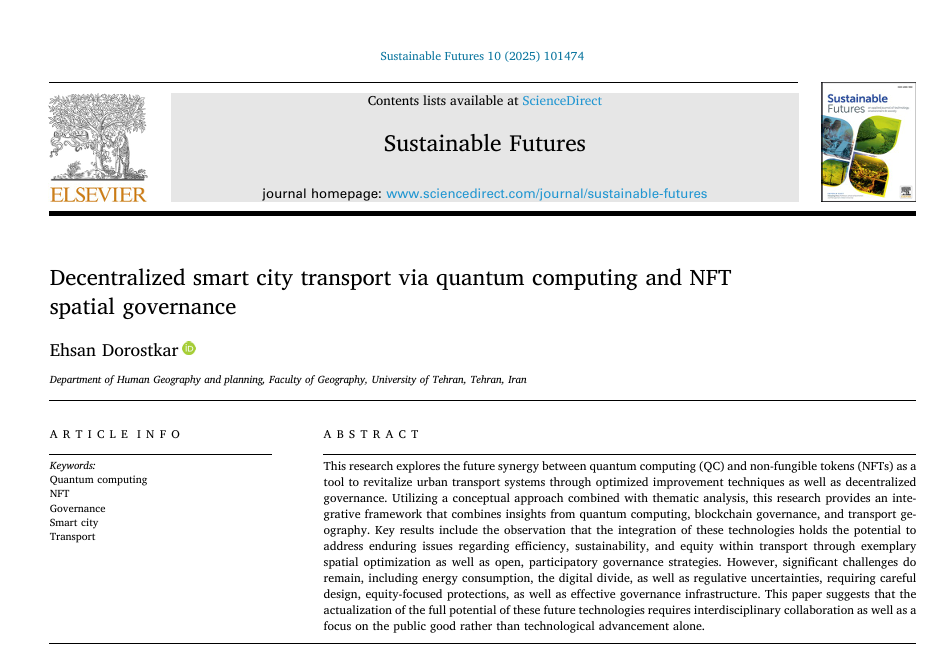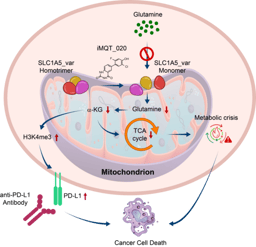The Future of Urban Transport: Merging Quantum Computing and NFTs for Smarter Cities
Published in Social Sciences and Earth & Environment

Explore the Research
 sciencedirect.com
sciencedirect.com
Just a moment...
Skip to main content
Our cities are grappling with a triple threat: chronic traffic congestion, unsustainable environmental footprints, and deep-seated inequities in access to mobility. While smart city initiatives have made incremental progress, a true breakthrough requires a fundamental rethinking of both our computational tools and our governance models.
Enter two disruptive technologies on the horizon: Quantum Computing (QC) and Non-Fungible Tokens (NFTs). While they might seem like buzzwords from different worlds, their convergence holds the key to building more efficient, sustainable, and equitable urban transport systems. Let's explore how.
Quantum Computing: Solving the Unsolvable
At its heart, quantum computing harnesses the strange laws of quantum mechanics to process information in fundamentally new ways. For transport geography, this is a game-changer. QC can solve complex optimization problems that are simply impossible for today's supercomputers to handle in a practical timeframe.
Imagine:
-
Real-time traffic management in a megacity, where quantum algorithms dynamically reroute thousands of vehicles simultaneously to prevent congestion before it starts.
-
Hyper-efficient logistics for global supply chains, using quantum machine learning to predict disruptions and reroute cargo, saving time, money, and carbon emissions.
-
Optimizing public transit routes to better serve underserved communities, making public transport a more attractive and equitable option for all.
By moving from heuristic approximations to precise, quantum-optimized solutions, we can unlock unprecedented levels of efficiency and sustainability.
NFTs: Beyond Digital Art to Decentralized Governance
Forget the hype around million-dollar jpegs. The underlying technology of NFTs—unique, verifiable digital assets on a blockchain—can revolutionize how we govern urban space.
In a transport system, NFTs could represent:
-
Tokenized infrastructure, like a parking space or an electric vehicle charging station, managed by smart contracts that adjust availability and pricing in real-time based on demand.
-
Mobility passes that grant personalized, multi-modal access to public transport, with smart contracts ensuring subsidies for low-income users or rewards for choosing carbon-neutral options.
-
Data ownership, where anonymized traffic or pollution data is tokenized, allowing researchers and citizens to access, verify, and contribute to public data commons without centralized control.
This paves the way for Decentralized Autonomous Organizations (DAOs), where citizens holding governance NFTs can vote directly on infrastructure investments or policy changes, creating a truly participatory model for urban mobility.
The Powerful Synergy (And Its Challenges)
When combined, Quantum Computing and NFTs create a powerful feedback loop for a self-adapting mobility ecosystem:
-
QC analyzes vast amounts of data to predict traffic flow and demand with incredible speed and accuracy.
-
NFTs and smart contracts execute these insights in the physical world, dynamically adjusting tolls, opening new transit lanes, or allocating resources.
However, this future is not without its risks. Key challenges include:
-
Energy Consumption: Powering quantum computers and blockchains must be addressed with renewable energy and efficient consensus mechanisms.
-
The Digital Divide: Without careful design, these systems could benefit only the digitally privileged. We must embed equity through physical access points, subsidy models, and digital literacy programs.
-
Regulatory Uncertainty: Governments will need to catch up to address issues like algorithmic bias and the monopolization of digital transport assets.
The Road Ahead: A Human-Centric Approach
The convergence of quantum computing and NFTs is not a silver bullet, but a powerful platform for innovation. Its success won't be determined by the technology itself, but by how we embed it within our social and policy frameworks.
To realize this vision, we need interdisciplinary collaboration—where transport geographers, quantum physicists, blockchain developers, and urban planners co-design systems that serve human needs, not the other way around. The goal is a future of urban mobility that is not just smart, but also equitable, resilient, and truly democratic.
Source:
Dorostkar, E. (2025). Decentralized smart city transport via quantum computing and NFT spatial governance. Sustainable Futures, 10, 101474. https://doi.org/10.1016/j.sfrr.2025.101474
Follow our research on Twitter | LinkedIn

Please sign in or register for FREE
If you are a registered user on Research Communities by Springer Nature, please sign in